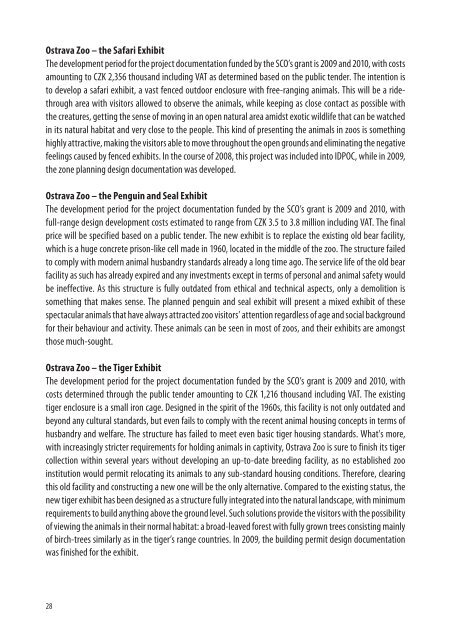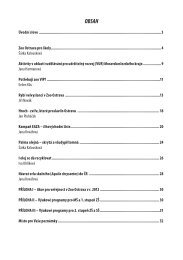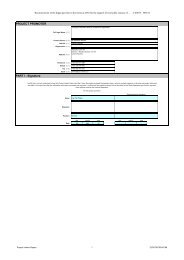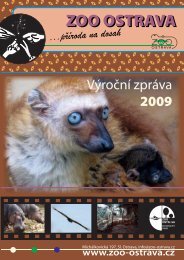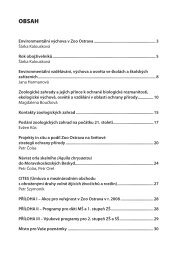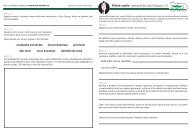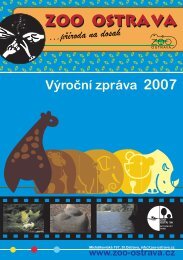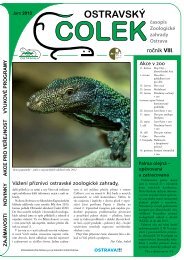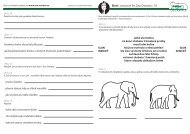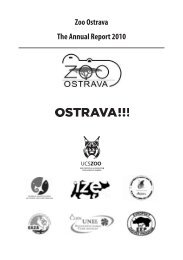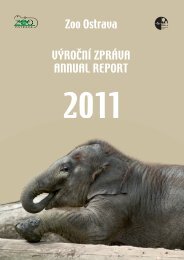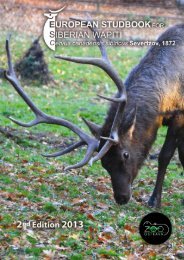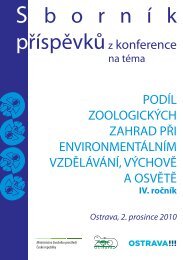Create successful ePaper yourself
Turn your PDF publications into a flip-book with our unique Google optimized e-Paper software.
<strong>Ostrava</strong> <strong>Zoo</strong> – the Safari Exhibit<br />
<strong>The</strong> development period for the project documentation funded by the SCO’s grant is <strong>2009</strong> and 2010, with costs<br />
amounting to CZK 2,356 thousand including VAT as determined based on the public tender. <strong>The</strong> intention is<br />
to develop a safari exhibit, a vast fenced outdoor enclosure with free-ranging animals. This will be a ridethrough<br />
area with visitors allowed to observe the animals, while keeping as close contact as possible with<br />
the creatures, getting the sense of moving in an open natural area amidst exotic wildlife that can be watched<br />
in its natural habitat and very close to the people. This kind of presenting the animals in zoos is something<br />
highly attractive, making the visitors able to move throughout the open grounds and eliminating the negative<br />
feelings caused by fenced exhibits. In the course of 2008, this project was included into IDPOC, while in <strong>2009</strong>,<br />
the zone planning design documentation was developed.<br />
<strong>Ostrava</strong> <strong>Zoo</strong> – the Penguin and Seal Exhibit<br />
<strong>The</strong> development period for the project documentation funded by the SCO’s grant is <strong>2009</strong> and 2010, with<br />
full-range design development costs estimated to range from CZK 3.5 to 3.8 million including VAT. <strong>The</strong> final<br />
price will be specified based on a public tender. <strong>The</strong> new exhibit is to replace the existing old bear facility,<br />
which is a huge concrete prison-like cell made in 1960, located in the middle of the zoo. <strong>The</strong> structure failed<br />
to comply with modern animal husbandry standards already a long time ago. <strong>The</strong> service life of the old bear<br />
facility as such has already expired and any investments except in terms of personal and animal safety would<br />
be ineffective. As this structure is fully outdated from ethical and technical aspects, only a demolition is<br />
something that makes sense. <strong>The</strong> planned penguin and seal exhibit will present a mixed exhibit of these<br />
spectacular animals that have always attracted zoo visitors’ attention regardless of age and social background<br />
for their behaviour and activity. <strong>The</strong>se animals can be seen in most of zoos, and their exhibits are amongst<br />
those much-sought.<br />
<strong>Ostrava</strong> <strong>Zoo</strong> – the Tiger Exhibit<br />
<strong>The</strong> development period for the project documentation funded by the SCO’s grant is <strong>2009</strong> and 2010, with<br />
costs determined through the public tender amounting to CZK 1,216 thousand including VAT. <strong>The</strong> existing<br />
tiger enclosure is a small iron cage. Designed in the spirit of the 1960s, this facility is not only outdated and<br />
beyond any cultural standards, but even fails to comply with the recent animal housing concepts in terms of<br />
husbandry and welfare. <strong>The</strong> structure has failed to meet even basic tiger housing standards. What's more,<br />
with increasingly stricter requirements for holding animals in captivity, <strong>Ostrava</strong> <strong>Zoo</strong> is sure to finish its tiger<br />
collection within several years without developing an up-to-date breeding facility, as no established zoo<br />
institution would permit relocating its animals to any sub-standard housing conditions. <strong>The</strong>refore, clearing<br />
this old facility and constructing a new one will be the only alternative. Compared to the existing status, the<br />
new tiger exhibit has been designed as a structure fully integrated into the natural landscape, with minimum<br />
requirements to build anything above the ground level. Such solutions provide the visitors with the possibility<br />
of viewing the animals in their normal habitat: a broad-leaved forest with fully grown trees consisting mainly<br />
of birch-trees similarly as in the tiger’s range countries. In <strong>2009</strong>, the building permit design documentation<br />
was finished for the exhibit.<br />
28


